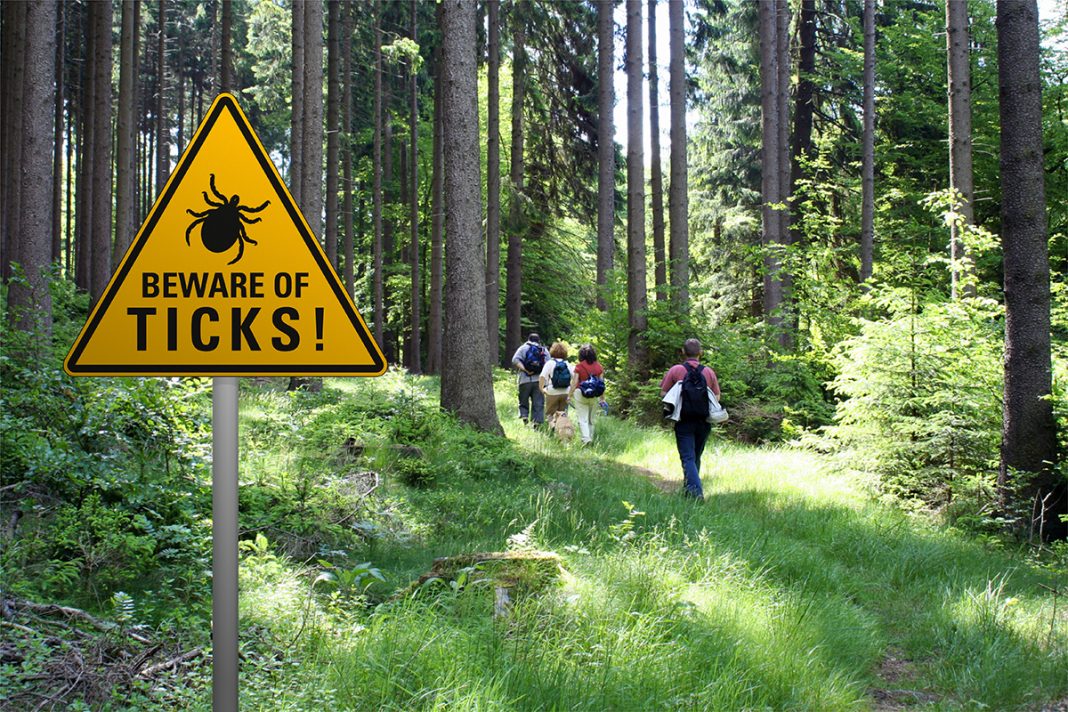MINDEMOYA – Lyme disease and how to prevent it was the timely topic at the May 31 meeting of the Manitoulin Nature Club (MNC). This condition is a serious infection marked by fever, headache, muscle and joint pain and a red-coloured rash. It is caused by the bite of a deer tick, also known by the name black-legged tick that carries the bacteria Borrelia burgdorferi. Lyme disease was named after Lyme, Connecticut, where the disease has been evident for 100 years. The bacteria is named for scientist Willy Burgdorfer who identified the cause of Lyme disease and connected it to ticks in 1981.
The guest speaker at this meeting was Dr. Andrew Peregrine, veterinarian and clinical parasitologist at the Ontario Veterinarian College of the University of Guelph.
Dr. Peregrine was educated in Scotland and worked in Kenya for nine years doing research to control parasites in cattle. He came to Canada in 1997 when, he said, “there was no need to worry about ticks.”
He began his talk by telling the members that he would be speaking on the consensus opinions of those knowledgeable about Lyme disease and noted that the risk of this condition is rising in Ontario. Public Health Ontario has marked the upswing in this province and showed 1,003 cases in 2017 with 31 hospitalizations. Risk maps for 2019 again show further increases in the tick population.
Dr. Peregrine’s talk focused on the deer tick because the American dog tick, also prevalent in Ontario, does not cause Lyme disease. He explained, with slides, that one can identify the deer tick as there is a hard section behind its head called a scutum that is a solid colour. On other ticks, this area is multi-coloured.
The deer tick feeds on blood to produce eggs and then lays the eggs in a relatively humid environment. “Like long grass,” Dr. Peregrine noted. He outlined the tick stages from larvae, which feeds on voles, mice, and other small mammals, to nymph, to adult, and then engorged adult. The nymph and adult ticks feed on dogs, cats, coyotes, raccoons and people.
“The adults love feasting on white-tailed deer,” Dr. Peregrine spelled out. “The deer do not get infected by the bacteria that causes Lyme disease.” The eggs drop off into the environment and the ideal area, as Dr. Peregrine said, “is the edge of deciduous forests. You usually only see the adult ticks, as they are big enough to see.”
Smaller ticks are the size of, and look like, poppy seeds. “The life cycle is typically two years,” Dr. Peregrine added.
Of a particular problem with the distribution of the deer tick is not only that they love deer that travel various distances throughout the province, but also that the tick larvae attach to birds. “One of the drivers is the migration of birds from the United States,” Dr. Peregrine stated. “Ticks in the northwest United States have increased a lot recently.” The national parks on Lake Erie and Lake Ontario show the presence of ticks carried by migratory birds and, “ticks are spreading 20 to 25 kilometres yearly in eastern Ontario because the environment is ideal for ticks,” Dr. Peregrine said. “Data in Ontario on ticks was started after 1997 and in 2008 showed nothing for Manitoulin. A lot of ticks were submitted on Manitoulin in 2017,” Dr. Peregrine noted, “but none were infected.” It was then that Island Animal Hospital veterinarian Johanne Paquet remarked that she has seen 20 cases of Lyme disease in dogs in the last five years.
Dr. Peregrine showed maps with the distribution of ticks from 2017 to 2019 and the difference in numbers is unreal. “In a year or two,” he stated, “Manitoulin will have a large population.” He explained the modified distribution is due to changing bird migration, changes in the deer population, reforestation and climate change. “In 2020,” he said, “almost all of southern Ontario will be at high risk for ticks.” He added that “Manitoulin has the perfect climate and environment for ticks. Be cautious in woods. Wear long pants, tucked into socks, wear insect repellent with DEET sprayed onto pants and long-sleeved shirts. Check yourself every day for ticks. The scalp, armpits, groin and the back of the neck are mostly where ticks are found. Carefully remove them with tweezers.”
Dogs should be carefully checked for ticks as they can be infected with numerous diseases besides Lyme. Minimize risk as Dr. Peregrine recommends by using good tick products attainable from a veterinarian. A vaccine is also available.
Suspect a deer tick bite? See a doctor immediately. Human cases have gone up substantially since 2010. As Dr. Peregrine explained, treatment within two weeks is usually successful. All cases, even the probable ones, now have to be reported. “The testing system is extremely good if an accredited lab is used,” Dr. Peregrine explained, “and are good in Canadian public health.”
Dr. Peregrine ended his presentation by taking questions and by telling the members that the lone star tick is on Canada’s doorstep. It is now prevalent from Texas to Maine and “will almost certainly come in,” he said, “what you would expect with climate change.”





